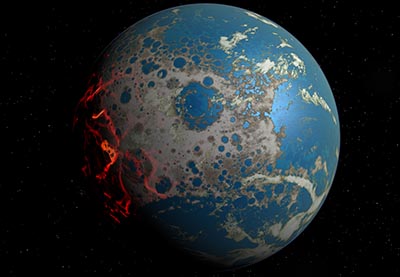SwRI-led team’s research shows giant asteroids battered early Earth

Image Courtesy of Simone Marchi An artistic conception of the early Earth, showing a surface pummeled by large impacts, resulting in extrusion of deep-seated magma onto the surface. At the same time, the distal portion of the surface could have retained liquid water.
The model, calibrated using existing lunar and terrestrial data, sheds light on the role asteroid collisions played in the geological evolution of the uppermost layers of Earth during the geologic eon call the “Hadean,” or first geologic eon, approximately four to 4.5 billion years ago.
The team, which also included academic and government researchers, published its findings in a paper, “Widespread Mixing and Burial of Earth’s Hadean Crust by Asteroid Impacts,” in the July 31, 2014, issue of the journal Nature.
An artistic conception of the early Earth, showing a surface pummeled by large impacts, resulting in extrusion of deep-seated magma onto the surface. At the same time, the distal portion of the surface could have retained liquid water.
“Prior to approximately four billion years ago, no large region of Earth’s surface could have survived untouched by impacts and their effects,” said Dr. Simone Marchi, lead author of the paper and a planetary scientist in SwRI’s Planetary Science Directorate in Boulder, Colo. “The new picture of the Hadean Earth emerging from this work has important implications for its habitability,” Marchi said.
Large impacts had particularly severe effects on existing ecosystems. Researchers found that on average, Hadean Earth more than four billion years ago could have been hit by one to four impactors that were more than 600 miles wide and capable of global sterilization, and by three to seven impactors more than 300 miles wide and capable of global ocean vaporization.
“During that time, the lag between major collisions was long enough to allow intervals of more clement conditions, at least on a local scale,” Marchi said. “Any life emerging during the Hadean eon likely needed to be resistant to high temperatures and could have survived such a violent period in Earth’s history by thriving in niches deep underground or in the ocean’s crust.”
The research was supported in part by NASA’s Solar System Exploration Research Virtual Institute (SSERVI) at NASA’s Ames Research Center in Moffett Field, Calif.
“A large asteroid impact could have buried a substantial amount of Earth’s crust with impact-generated melt,” said Dr. Yvonne Pendleton, SSERVI director at Ames. “This new model helps explain how repeated asteroid impacts may have buried Earth’s earliest and oldest rocks.”
Terrestrial planet formation models indicate Earth went through a sequence of major growth phases: initially accretion of planetesimals — planetary embryos — over many tens of millions of years; then a giant impact that led to the formation of the Moon; followed by the late bombardment when giant asteroids several tens to hundreds of miles in size periodically hit ancient Earth, dwarfing the one that presumably killed the dinosaurs (estimated to be six miles in size), only 65 million years ago.
Researchers estimate that accretion during the late bombardment contributed less than one percent of Earth’s present-day mass, but the giant asteroid impacts still had a profound effect on the geological evolution of early Earth. Prior to four billion years ago Earth was resurfaced over and over by voluminous, impact-generated melt.
Furthermore, large collisions as late as about four billion years ago may have repeatedly boiled away existing oceans into steamy atmospheres. Despite the heavy bombardment, the findings are compatible with the claim of liquid water on Earth’s surface as early as about 4.3-4.4 billion years ago based on geochemical data.
The new research reveals that asteroidal collisions not only severely altered the geology of the Hadean eon Earth, but also likely played a major role in the evolution of life on early Earth as well.
The team was comprised of Marchi and Dr. William Bottke from SwRI; L. Elkins-Tanton from Carnegie Institution for Science in Washington; M. Bierhaus and K. Wünnemann from the Museum fur Naturkunde in Berlin, Germany; A. Morbidelli from Observatoire de la Côte d’Azur in Nice, France; and D. Kring from the Universities Space Research Association and the Lunar and Planetary Institute in Houston.
SSERVI is a virtual institute that, with international partnerships, brings science and exploration researchers together in a collaborative virtual setting. SSERVI is funded by the Science Mission Directorate and Human Exploration and Operations Mission Directorate at NASA Headquarters in Washington. For more information about SSERVI and selected member teams, visit: http://sservi.nasa.gov.
Editors: An artistic conception of the early Earth is available at: http://www.swri.org/press/2014/hadean-earth.htm.
For more information, contact Joe Fohn, (210) 522-4630, Communications Department, Southwest Research Institute, PO Drawer 28510, San Antonio, TX 78228-0510.
Media Contact
More Information:
http://www.swri.org/9what/releases/2014/hadean-earth.htm#.U9tbBWEcTcsAll latest news from the category: Earth Sciences
Earth Sciences (also referred to as Geosciences), which deals with basic issues surrounding our planet, plays a vital role in the area of energy and raw materials supply.
Earth Sciences comprises subjects such as geology, geography, geological informatics, paleontology, mineralogy, petrography, crystallography, geophysics, geodesy, glaciology, cartography, photogrammetry, meteorology and seismology, early-warning systems, earthquake research and polar research.
Newest articles

Silicon Carbide Innovation Alliance to drive industrial-scale semiconductor work
Known for its ability to withstand extreme environments and high voltages, silicon carbide (SiC) is a semiconducting material made up of silicon and carbon atoms arranged into crystals that is…

New SPECT/CT technique shows impressive biomarker identification
…offers increased access for prostate cancer patients. A novel SPECT/CT acquisition method can accurately detect radiopharmaceutical biodistribution in a convenient manner for prostate cancer patients, opening the door for more…

How 3D printers can give robots a soft touch
Soft skin coverings and touch sensors have emerged as a promising feature for robots that are both safer and more intuitive for human interaction, but they are expensive and difficult…




















